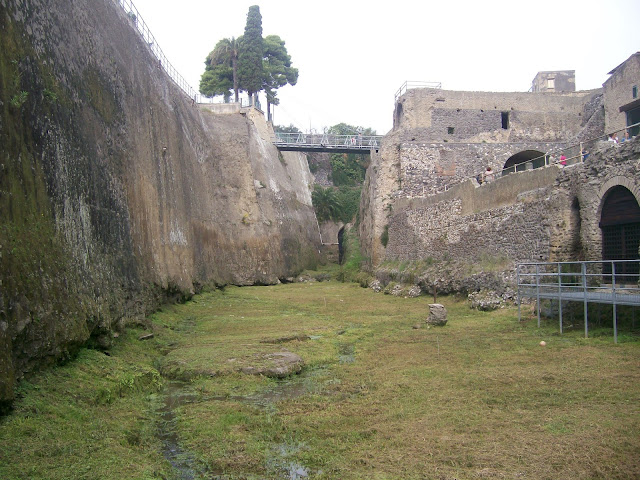Herculaneum
Herculaneum was a very ordinary and unremarkable town - made famous today because of its preservation by the same volcanic eruption that destroyed Pompeii.
Pompeii was slowly buried under a fall of ash, pumice and small stones but Herculaneum was destroyed in a different manner. A super-heated surge of toxic gas instantly killed its inhabitants, then a pyroclastic flow of scorching volcanic material flowed down from Vesuvius and entombed the town, burying it in over 20 metres of material.
The town was only discovered in 1711 when people digging a well discovered the long-buried theatre. Most of the excavation work in Herculaneum was carried out in the 1920s and 1930s under the direction of Amadeo Maiuri and only half of the town has been excavated.
I returned three months later and the first thing that struck me was the obvious and ongoing drainage issues the site suffers.
Pompeii was slowly buried under a fall of ash, pumice and small stones but Herculaneum was destroyed in a different manner. A super-heated surge of toxic gas instantly killed its inhabitants, then a pyroclastic flow of scorching volcanic material flowed down from Vesuvius and entombed the town, burying it in over 20 metres of material.
The town was only discovered in 1711 when people digging a well discovered the long-buried theatre. Most of the excavation work in Herculaneum was carried out in the 1920s and 1930s under the direction of Amadeo Maiuri and only half of the town has been excavated.
I returned three months later and the first thing that struck me was the obvious and ongoing drainage issues the site suffers.
View of the ancient beach/sea front taken in September 2012
Same place, January 2013 showing considerable ponding of water after heavy rainfall.
This contributes to drainage problems in the nearby Suburban Baths, subjecting it to regular flooding and rising damp. The Suburban Baths were closed on both my visits.
Following are some photos taken on my visits in September 2012 and January 2013.
View of one of the small streets
Painted sign from the House of the Black Saloon. The painted sign advertises a wine shop. It is behind Perspex to protect it from the elements as well as tourists who like to scratch their name into these ancient frescoes - much to my eternal disbelief.
This is the Decumanus Maximus - the 'main street' of Herculaneum.
A thermopolia (snack bar) - large jars (dolia) containing hot food were inside the round holes. Our equivalent today would be a cafeteria or fast-food outlet. I guess the thermopolia were the 'McDonalds' of their time.
Religion was a very important part of life in Herculaneum. This fresco is from the Augusteum - an 'imperial cult' devoted to the worship of the divine Augustus, the Roman Empire's first Emperor and was probably constructed during the Julio-Claudian period. This wonderful fresco shows images from Greek mythology.
What's extraordinary about Herculaneum is the preservation of the site. Because it was covered with different volcanic material to Pompeii, organic material was preserved. This photo shows the House of the Wooden Partition. These are wooden doors on bronze tracks, in perfect condition and over 2000 years old.
Now for the sad stuff. Modern graffiti. What on earth would possess anyone to scratch their name on ancient walls? I seriously don't get why these idiots do it. This photo is from the Samnite House, which has recently re-opened after considerable restoration work.
A floor mosaic from the Central Baths. Note the buckling of the floor which occurred during the eruption.
Herculaneum is only 4 hectares, so it is easy to cover it in a few hours. I visited it twice in a short space of time as there were things I missed the first time around and on the second visit, there were places open that were previously closed. I'll be back again!












Comments
Post a Comment